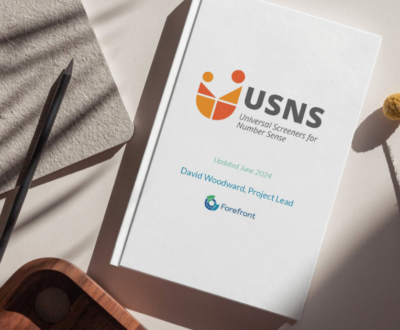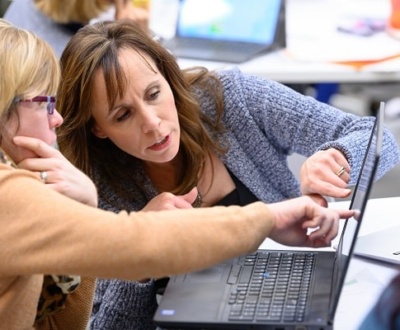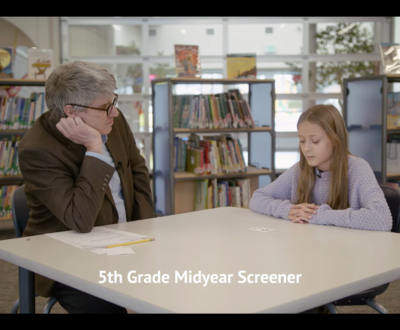9 Tips for Improved Math Instruction
- May 16, 2024
- Blog
Broad scale assessments of mathematics performance in the United States indicate declining overall performance in mathematics. While the COVID pandemic certainly played a role in these results, there are likely a variety of variables at play. While these broad trends are concerning, the only way that we will change these trends is by improving math instruction classroom by classroom, student by student.
Here are 9 things to consider as you teach in your own classroom, or in your role as an instructional leader. While you might be adopting new instructional materials or new electronic platforms to attempt to spark growth, consider these aspects about learning that transcend products and instead focus on high quality instructional practices. They include a focus on building positive mindsets, gathering information about students’ critical mathematical understandings, and using formative information to target instruction.
Plan, Focus, and Prepare Resources
Focus is essential, but knowing where to be flexible and where to be firm is critical.
When it comes to K-5 mathematics, teachers need to make decisions quickly as they react to the increasingly diverse needs of students. Teachers require flexibility to respond to the needs of their students, but guidance and resources from leaders is still essential. Provide documents to help teachers understand for which topics to slow down and teach for mastery, and which topics to introduce and assess.
It is difficult to say that any topics of K-5 mathematics should be skipped, but knowing what to emphasize and focus on is important. These include critical skills and concepts, of course, but they also must include practice standards. Key practices to seek to build in our students include the ability to reason and communicate reasoning with words and visual models, the ability to persist and seek understanding, the ability to model with mathematics.
Teach for Understanding
I love how teaching math for understanding so very often comes with a smile. The ah-ha moment, when things click and lightbulbs go on, is delightful. When math is taught for understanding, it is joyful. The opposite, which mathematics seems to have a particular potential for, is frustration, anger, disengagement, and avoidance.
We need joy! Students will need opportunities to reason through problems, to think out loud, to draw to help them solve problems, and ample time for problem-solving. Teaching students to memorize the steps of algorithms they do not understand does not help them in the short or long run. One problem well understood is worth a hundred misunderstood (even if some answers are right.)
Helping students to make sense of mathematics is central to what we must do as teachers. This means number sense, of course, but it also means communication: talking, playing, drawing, building, and storytelling.
Use Visual Models
Visual models are essential for teaching for understanding. It is no coincidence that to say “I see,” means, “I understand.” Nowhere is this more true than in the world of mathematics, where spatial reasoning is often interwoven with the concepts being taught. There are many great tools out there (and in your classrooms) to help with this; here are a few links to some great (and free) resources: PhET , Math Learning Center Apps , Visual Patterns.
Your instructional program might have certain visual models (and/or manipulatives) that are integrated into the program. These are important to discuss as a school community. Building consistent use around a core set of visual models (e.g., number lines, area models, place value drawings, and number bonds) is essential because these become tools for new learning, and it takes time to build a depth of understanding. As a community, agree on the visual models that you employ and expect students to use, and seek to build continuity across classrooms and grade levels.
Create Positive Engagement
Play games, watch, listen, and take notes. Card, dice, and spinner games are not only fun, but great ways for students to get to know one another, talk meaningfully about mathematics, engage with, and practice and develop fluency with critical skills. There are many great games out there. The Math Learning Center put out a wonderful set of ideas during the pandemic that include some very fun games.
If you can find a copy of Everyday Mathematics Teacher’s Guide to Games, you will be set for hours and hours of fun games for all levels.
One other favorite set of ideas is puzzle-like activities of Steve Wyborney. From the whimsical Splat activities to thoughtful Esti-Mysteries, these set the stage for thinking, talking, and enjoying mathematics. Integrating activities from Steve’s website is a great way to get the year started.
Use extended tasks. If you are not familiar with 3-Act tasks, Graham Fletcher ’s website is the place to start learning. If you are familiar, you are likely already using some of these fantastic tasks. What a great way to start a year in mathematics, with lots of collaboration, sense making, and appropriate challenge! Have your clipboard handy to take notes of what you see your students doing well and where there is unfinished learning.
Encourage Growth Mindsets
Supporting and encouraging growth mindsets is always important. Students need to believe in their own capability to learn and that the more they learn, the smarter they get. Consider using some or all of the ideas in Jo Boaler’s very popular and interesting Week of Inspirational Math.
Build Low Floors and High Ceilings
Engagement follows understanding. Support initial understanding that enables students to connect to what you are teaching, and learning will follow.
For many students, ample supports and tasks that are very accessible and which enable quick and early successes are indispensable. Meanwhile, students will also be ready to grow quickly as the excitement of learning sets in.
Nrich.maths.org is a wonderful source of good ideas for creating low threshold, high ceiling tasks and classrooms. These activities can fuel elementary math instruction.
Don’t Start with a Test
Formative assessment will be critical, however, do not sit your students down for endless pages (physical or digital) of math assessments during the first weeks of school. This makes everyone suffer. If you must do some sort of extended paper and pencil, or digital assessment, try to wait until after you have already engaged your students with math in pleasant ways.
Observe Closely and Assess Formatively
Assessment does not need to happen on a computer or even with pencil and paper. Observe your students in order to understand them as learners. This observation is more important than a computer-based assessment. Take notes. Carry a clipboard. Ask questions. Sit with kids to play games and allow students to present their work to the class. Afterward, use this information to help you in your planning and collaborative work.
Screen for Number Sense
Do not screen students right away, but sometime late in the first month of school, universal screening is a good idea. It will help you to understand all of your students systematically and bring attention to skills and concepts that you might otherwise overlook. A systematic screening of the students in a school also can provide a helpful framework for coordinating efforts and setting meaningful, timely goals for targeted instruction. It helps to inform small group work, planning for pre-teaching, and targeted instruction efforts.
Universal screening is a critical component of MTSS/RtI systems and will help you understand if students are ready for grade-level work. I lead the open-source K-6 Universal Screeners for Number Sense (USNS) Project. The fall assessments are entirely interview-based. The math conversations help you gather information on key number sense indicators like verbal counting, one to one correspondence, mental math, operational sense, and number line knowledge.
These underlying skills and concepts act as the mental glue for other ideas. These number sense skills and concepts make the above games accessible and engaging. Number sense lays the groundwork for engagement, for communicating, and for enjoying mathematics.
Final Thoughts on Supporting Success in Math
Support another year of accelerated learning for all students. When teachers foster positive perceptions of mathematics and gather high-quality information to determine if students are ready for grade-level work, your classrooms will be joyful and students will be set up for success.
About us and this blog
Our team and tools help schools implement standards-based grading, streamline assessment systems, and use meaningful data to drive decision-making.
Free K-6 Math Screener
The Universal Screeners for Number Sense (USNS) assessments are interview-based and pencil and paper K-6 math screeners designed by teachers to assess for students' number sense. This open-source project provides free, high-quality assessment tools to over 9,000 schools in the US and internationally. Learn more and access your free copy below.
More from our blog
See all posts
Thank You A very sincere thanks to the entire community of USNS educators and for your…
In a world that is moving at hyper speed, "slow" movements embrace quality over speed. Slow…
As the 2023-24 school year comes to a close, it's a perfect time to conduct an…
Will 2024-25 be the first year of a new curriculum implementation for your school or district?…
Our school district, Walpole Public Schools in Massachusetts, adopted Bridges in Mathematics in the 2022-23 school…
As you begin to look to the fall to support your RtI/MTSS efforts to strengthen math…
Forefront is the only assessment data solution optimized for classroom assessment results, leveraging these results to fuel instruction, PLCs, and grading. Elevate meaningful assessment data district-wide to transform how you understand and communicate about student learning across your schools.








